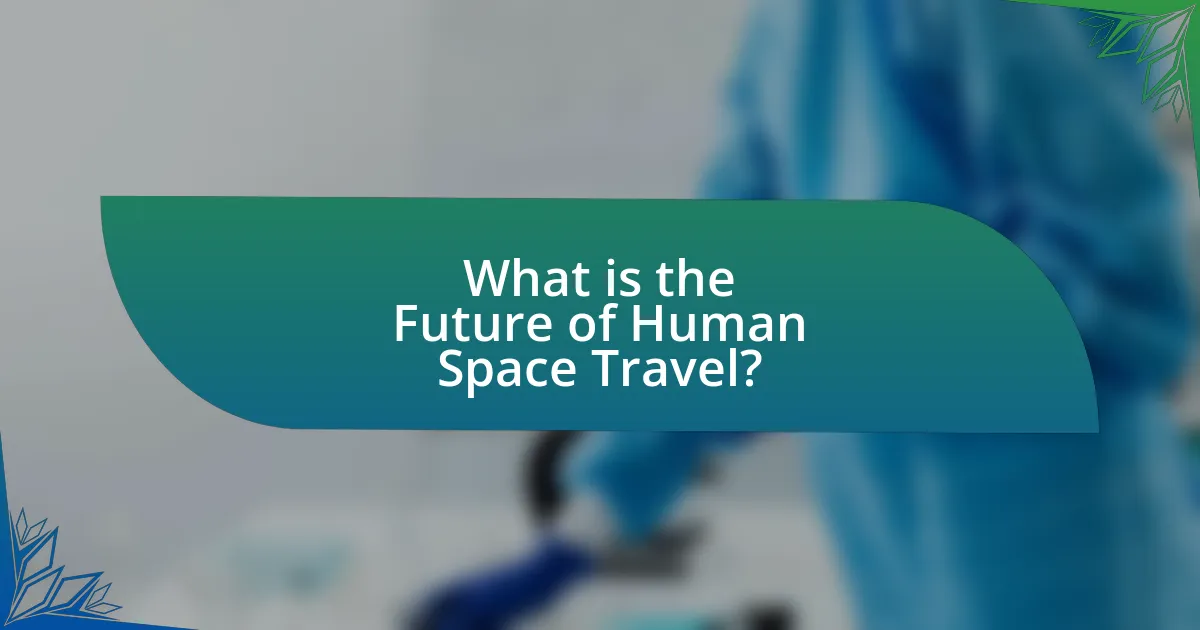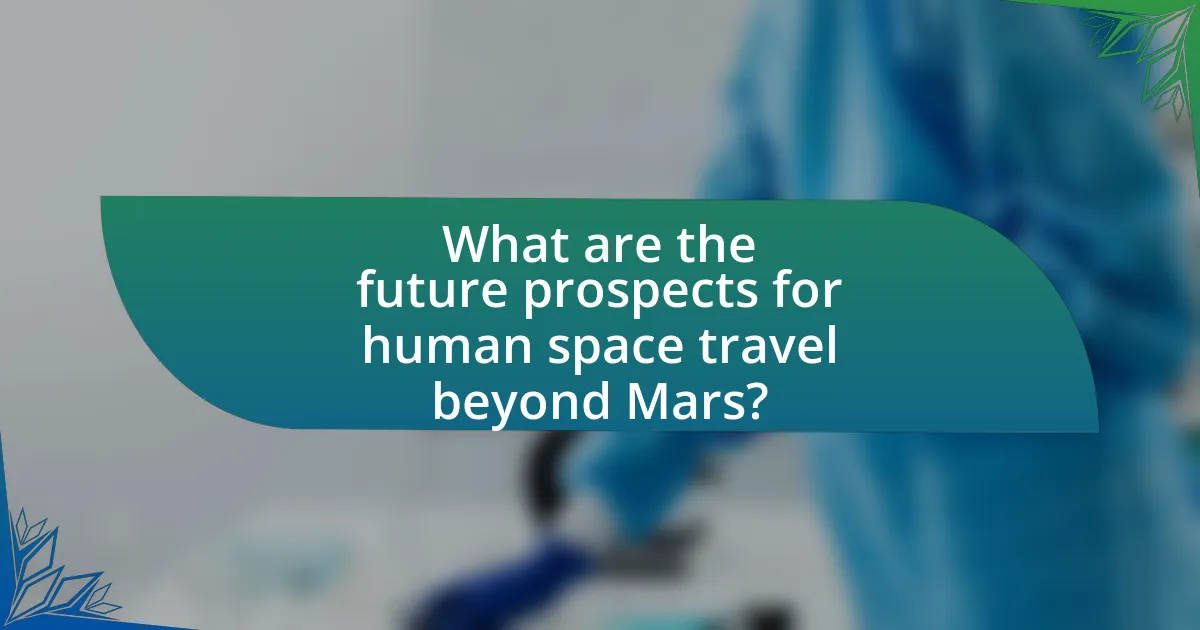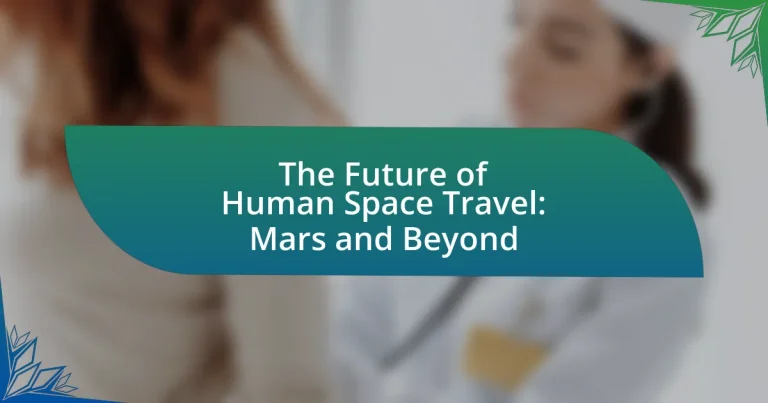The article focuses on the future of human space travel, particularly missions to Mars and beyond. It outlines NASA’s Artemis program, which aims to return humans to the Moon by 2024, and SpaceX’s Starship, designed for interplanetary travel. Key advancements in technology, such as reusable rockets and life support systems, are discussed, along with the impact of international collaborations and private sector involvement in enhancing space exploration. The article also addresses the unique challenges of traveling to Mars, the potential benefits of colonization, and the implications of exploring other celestial bodies, emphasizing the importance of sustainable life support systems and innovative transportation methods for future missions.

What is the Future of Human Space Travel?
The future of human space travel involves missions to Mars and beyond, with plans for sustained human presence on the Moon and eventual colonization of Mars. NASA’s Artemis program aims to return humans to the Moon by 2024, establishing a base for further exploration. Concurrently, SpaceX’s Starship is designed for interplanetary travel, with aspirations to send humans to Mars in the 2020s. These initiatives are supported by advancements in technology, such as reusable rockets and life support systems, which enhance the feasibility of long-duration space missions. The growing interest from private companies and international collaborations further indicates a robust future for human space exploration.
How is human space travel evolving in the 21st century?
Human space travel is evolving in the 21st century through advancements in technology, increased private sector involvement, and ambitious missions to Mars and beyond. Notable developments include NASA’s Artemis program, which aims to return humans to the Moon by 2024, and SpaceX’s Starship, designed for missions to Mars and beyond. The rise of private companies like Blue Origin and Virgin Galactic is also democratizing access to space, enabling suborbital flights for civilians and fostering competition that drives innovation. Furthermore, international collaborations, such as the Lunar Gateway project, are enhancing global partnerships in space exploration. These factors collectively indicate a significant shift towards more frequent and diverse human space travel opportunities.
What technological advancements are driving this evolution?
Technological advancements driving the evolution of human space travel to Mars and beyond include reusable rocket technology, advanced life support systems, and autonomous navigation systems. Reusable rocket technology, exemplified by SpaceX’s Falcon 9, significantly reduces launch costs and increases mission frequency, making space travel more economically viable. Advanced life support systems, such as those being developed by NASA for long-duration missions, ensure sustainable living conditions for astronauts by recycling air and water. Autonomous navigation systems, like those used in the Mars rovers, enhance mission safety and efficiency by allowing spacecraft to make real-time decisions during travel. These advancements collectively facilitate the feasibility and safety of human exploration beyond Earth.
How do international collaborations impact human space travel?
International collaborations significantly enhance human space travel by pooling resources, expertise, and technology from multiple countries. For instance, the International Space Station (ISS) is a prime example, involving space agencies from the United States, Russia, Europe, Japan, and Canada, which has led to advancements in scientific research and technology development. This collaboration has resulted in over 2,500 scientific investigations since its inception, demonstrating how shared knowledge accelerates innovation in space exploration. Furthermore, international partnerships facilitate cost-sharing, making ambitious missions, such as those aimed at Mars, more feasible by distributing financial burdens among participating nations.
Why is Mars a focal point for future missions?
Mars is a focal point for future missions due to its potential for past or present life and its suitability for human colonization. The planet’s similarities to Earth, including its day length and seasonal cycles, make it an attractive target for exploration. NASA’s Perseverance rover, which landed in February 2021, is actively searching for signs of ancient microbial life and collecting samples for future return to Earth, reinforcing Mars’ significance in astrobiology. Additionally, the presence of water ice at the poles and potential subsurface reservoirs could support human life, making Mars a key candidate for long-term human settlement and exploration.
What are the unique challenges of traveling to Mars?
Traveling to Mars presents unique challenges primarily due to its vast distance, harsh environment, and the need for sustainable life support systems. The average distance from Earth to Mars is approximately 225 million kilometers, which results in long-duration missions that can last from six months to over a year, requiring advanced spacecraft technology and life support systems to ensure crew safety and health.
Additionally, Mars has a thin atmosphere composed mostly of carbon dioxide, with surface temperatures averaging around minus 80 degrees Fahrenheit, creating challenges for landing, habitat construction, and human survival. Radiation exposure is another significant concern, as Mars lacks a protective magnetic field, increasing the risk of cancer and other health issues for astronauts.
Moreover, the psychological effects of isolation and confinement during long missions can impact crew dynamics and mental health, necessitating robust support systems. These challenges underscore the complexity of planning and executing human missions to Mars, as highlighted by NASA’s Artemis program and ongoing research into sustainable habitats and life support technologies.
How does Mars compare to other potential destinations in space?
Mars is often considered the most viable destination for human space travel compared to other celestial bodies due to its relatively Earth-like conditions. Its surface gravity is about 38% that of Earth, which is conducive for human habitation and long-term exploration. Additionally, Mars has a day length similar to Earth’s, with a 24.6-hour rotation period, making it easier for humans to adapt.
In contrast, destinations like Venus present extreme atmospheric pressure and temperatures that are inhospitable to human life, while the Moon, despite being closer, lacks the resources necessary for sustainable living, such as water in significant quantities. Furthermore, Mars has been found to have water ice at its poles and potential subsurface water, which is crucial for supporting human life and future colonization efforts.
These factors position Mars as a more favorable option for future human missions compared to other potential destinations in space.
What are the potential benefits of human space travel to Mars?
Human space travel to Mars offers significant benefits, including advancements in scientific knowledge, technological innovation, and potential solutions to Earth’s challenges. The exploration of Mars can lead to discoveries about the planet’s geology, climate, and potential for past or present life, enhancing our understanding of planetary science. For instance, NASA’s Perseverance rover is currently analyzing Martian soil and rock samples, which could provide insights into the planet’s history and habitability.
Additionally, the technological advancements required for Mars missions often have applications on Earth. Innovations in life support systems, robotics, and sustainable energy can improve technologies used in various industries. For example, developments in water recycling systems for Mars habitats can enhance water conservation technologies on Earth.
Moreover, human presence on Mars could inspire global collaboration and investment in space exploration, fostering international partnerships that drive economic growth and innovation. The potential for resource utilization on Mars, such as extracting water or minerals, could also alleviate resource scarcity on Earth.
In summary, human space travel to Mars can lead to profound scientific discoveries, technological advancements, and collaborative opportunities that benefit humanity as a whole.
How could Mars colonization benefit Earth?
Mars colonization could benefit Earth by providing a platform for scientific research and technological advancements. Establishing a human presence on Mars would drive innovation in areas such as life support systems, sustainable energy, and resource utilization, which could be applied to solve pressing issues on Earth. For instance, technologies developed for water recycling and agriculture in Martian habitats could enhance water conservation and food production methods on Earth, addressing challenges like drought and food security. Additionally, the exploration of Martian resources, such as water ice and minerals, could lead to new materials and energy sources that benefit Earth’s economy and environment. Historical precedents, such as the advancements in satellite technology from space exploration, demonstrate how investments in space can yield significant returns in technology and quality of life on Earth.
What scientific discoveries could be made through Mars exploration?
Mars exploration could lead to significant scientific discoveries, including evidence of past or present microbial life, insights into planetary formation and evolution, and understanding of Martian geology and climate. The search for microbial life is crucial, as missions like the Mars 2020 Perseverance rover aim to collect samples that may contain biosignatures, indicating life existed on Mars. Additionally, studying Martian soil and rock samples can reveal information about the planet’s history, including volcanic activity and water presence, which are essential for understanding its evolution. Research conducted by NASA and other space agencies has already identified ancient river valleys and lake beds, suggesting that Mars once had conditions suitable for life.

What are the key challenges of human space travel to Mars?
The key challenges of human space travel to Mars include radiation exposure, life support sustainability, psychological effects, and the technical complexities of long-duration spaceflight. Radiation exposure poses significant health risks, as astronauts would be subjected to higher levels of cosmic radiation beyond Earth’s protective atmosphere, increasing the likelihood of cancer and other illnesses. Life support sustainability is critical, as systems must efficiently recycle air, water, and food for potentially years, requiring advanced technology and reliability. Psychological effects arise from isolation and confinement during the lengthy journey, which can impact mental health and team dynamics. Finally, the technical complexities involve developing spacecraft capable of safely transporting humans to Mars and back, including propulsion systems, landing technologies, and habitat construction on the Martian surface. These challenges necessitate extensive research and development to ensure the safety and success of future missions.
How do we address the health risks for astronauts on long-duration missions?
To address the health risks for astronauts on long-duration missions, space agencies implement a combination of preventive measures, monitoring systems, and countermeasures. Preventive measures include rigorous pre-mission health screenings and training to ensure astronauts are physically and mentally prepared for extended space travel. Monitoring systems involve continuous health assessments using wearable technology that tracks vital signs and physiological changes during the mission. Countermeasures, such as exercise regimens, nutritional plans, and psychological support, are designed to mitigate the effects of microgravity and isolation. Research indicates that regular exercise can counteract muscle atrophy and bone density loss, which are significant risks during long missions, as evidenced by studies conducted on the International Space Station.
What are the psychological effects of isolation in space?
The psychological effects of isolation in space include increased anxiety, depression, and cognitive decline. Research conducted during the Mars Society’s Mars Desert Research Station simulations revealed that prolonged isolation can lead to feelings of loneliness and social withdrawal, significantly impacting mental health. Additionally, NASA’s studies on astronauts have shown that extended missions can result in mood swings and impaired decision-making abilities due to the lack of social interaction and environmental stimuli. These findings underscore the importance of addressing mental health challenges in future long-duration space missions.
How can we mitigate radiation exposure during the journey?
To mitigate radiation exposure during the journey, spacecraft can utilize shielding materials, such as polyethylene or water, which effectively absorb and deflect harmful cosmic rays. Research indicates that polyethylene is particularly effective due to its high hydrogen content, which can reduce radiation levels by up to 90% in certain configurations. Additionally, spacecraft design can incorporate areas with increased shielding for crew members to take refuge during solar particle events, further minimizing exposure. Implementing these strategies is crucial for ensuring astronaut safety on long-duration missions to Mars and beyond.
What logistical challenges must be overcome for Mars missions?
Mars missions face significant logistical challenges, including transportation, life support, and communication. Transportation involves developing spacecraft capable of safely carrying humans and cargo over the vast distance of approximately 225 million kilometers, requiring advanced propulsion systems and fuel efficiency. Life support systems must provide sustainable air, water, and food for extended periods, as current technology limits resupply options from Earth. Communication challenges arise from the time delay of signals, which can take between 4 to 24 minutes to travel one way, complicating real-time interactions and mission control. These challenges necessitate innovative solutions and extensive planning to ensure the success of human missions to Mars.
How will we ensure sustainable life support systems on Mars?
To ensure sustainable life support systems on Mars, we will implement closed-loop life support systems that recycle air, water, and waste. These systems will utilize advanced technologies such as bioregenerative systems, which integrate biological processes to produce food and oxygen while purifying water. Research conducted by NASA’s Mars Society indicates that using hydroponics and aeroponics can significantly enhance food production efficiency in Martian conditions. Additionally, in-situ resource utilization (ISRU) will be critical, allowing us to extract water from the Martian soil and produce oxygen from carbon dioxide in the atmosphere. This approach not only reduces the need for resupply missions from Earth but also creates a self-sustaining environment for long-term human habitation.
What transportation methods are being developed for Mars travel?
Transportation methods being developed for Mars travel include SpaceX’s Starship, NASA’s Space Launch System (SLS), and various concepts for in-situ resource utilization (ISRU) vehicles. SpaceX’s Starship is designed for deep space missions and aims to facilitate crewed missions to Mars with its fully reusable launch system. NASA’s SLS is a powerful rocket intended to support crewed missions to Mars by providing the necessary lift capacity. Additionally, ISRU vehicles are being conceptualized to utilize Martian resources for fuel and life support, enhancing sustainability for long-term missions. These developments are supported by ongoing research and testing, demonstrating a commitment to advancing human exploration of Mars.

What are the future prospects for human space travel beyond Mars?
The future prospects for human space travel beyond Mars include missions to the moons of Jupiter and Saturn, particularly Europa and Enceladus, which are considered potential sites for extraterrestrial life. NASA’s Artemis program aims to establish a sustainable human presence on the Moon by the late 2020s, serving as a stepping stone for deeper space exploration. Additionally, private companies like SpaceX are developing technologies for interplanetary travel, with plans for crewed missions to destinations such as the asteroid belt and beyond. The feasibility of these missions is supported by advancements in propulsion systems, life support technologies, and international collaboration in space exploration initiatives.
What other celestial bodies are being considered for human exploration?
NASA and other space agencies are considering several celestial bodies for human exploration, including the Moon, Mars, Europa, and Titan. The Moon is targeted for the Artemis program, aiming for sustainable human presence by the late 2020s. Mars is a primary focus for future missions, with plans for crewed landings in the 2030s. Europa, one of Jupiter’s moons, is of interest due to its subsurface ocean, which may harbor life, while Titan, Saturn’s largest moon, has a dense atmosphere and liquid methane lakes, making it a candidate for exploration. These bodies are selected based on their potential for scientific discovery and the possibility of supporting human life.
How does the Moon serve as a stepping stone for deeper space exploration?
The Moon serves as a stepping stone for deeper space exploration by providing a platform for testing technologies and conducting research necessary for long-duration missions. Its proximity to Earth, approximately 238,855 miles away, allows for easier access and quicker turnaround times for missions compared to distant destinations like Mars. NASA’s Artemis program aims to establish a sustainable human presence on the Moon, which will facilitate the development of life support systems, habitats, and resource utilization techniques, such as in-situ resource utilization (ISRU) for water and oxygen extraction. These advancements are critical for future missions to Mars, where similar challenges will arise. Historical missions, such as Apollo, demonstrated the feasibility of human exploration and laid the groundwork for ongoing lunar research, reinforcing the Moon’s role as a vital testing ground for technologies that will be essential for deeper space exploration.
What are the implications of exploring asteroids and beyond?
Exploring asteroids and beyond has significant implications for resource acquisition, scientific advancement, and planetary defense. The potential to mine asteroids for valuable materials, such as rare metals and water, could support future space missions and reduce reliance on Earth resources. For instance, NASA’s OSIRIS-REx mission successfully collected samples from the asteroid Bennu, demonstrating the feasibility of asteroid mining. Additionally, studying asteroids can enhance our understanding of the solar system’s formation and evolution, providing insights into planetary science. Furthermore, exploring these celestial bodies aids in developing strategies for planetary defense against potential asteroid impacts, as evidenced by ongoing research into deflection techniques. Thus, the implications of exploring asteroids and beyond encompass economic, scientific, and safety dimensions critical for the future of human space travel.
How can private companies contribute to the future of human space travel?
Private companies can significantly contribute to the future of human space travel by developing innovative technologies, reducing costs, and increasing access to space. Companies like SpaceX have already demonstrated this by successfully launching reusable rockets, which lowers the cost of sending payloads to orbit. Additionally, private firms are investing in spacecraft designed for crewed missions, such as SpaceX’s Crew Dragon, which has transported astronauts to the International Space Station. Furthermore, partnerships between private companies and government agencies, like NASA’s Commercial Crew Program, facilitate knowledge sharing and resource allocation, enhancing the overall capabilities for human space exploration. These contributions are essential for ambitious goals, such as missions to Mars, as they enable more frequent and affordable access to space.
What roles do companies like SpaceX and Blue Origin play in this future?
Companies like SpaceX and Blue Origin are pivotal in shaping the future of human space travel by developing advanced technologies for space exploration and transportation. SpaceX’s Starship aims to facilitate missions to Mars, with the goal of establishing a sustainable human presence on the planet, while Blue Origin focuses on suborbital and orbital flights, promoting space tourism and research. Both companies are driving down launch costs through reusable rocket technology, evidenced by SpaceX’s Falcon 9, which has successfully completed numerous missions with reused boosters, significantly reducing expenses. Their innovations are crucial for enabling long-term human settlement beyond Earth, making interplanetary travel more feasible.
How can public-private partnerships enhance space exploration efforts?
Public-private partnerships can enhance space exploration efforts by leveraging the strengths of both sectors to accelerate innovation and reduce costs. For instance, NASA’s collaboration with private companies like SpaceX has led to the successful development of the Crew Dragon spacecraft, which significantly lowered the cost of transporting astronauts to the International Space Station. This partnership model allows for shared resources, expertise, and risk, enabling faster development timelines and increased mission capabilities. Additionally, the investment from private entities can stimulate technological advancements and create a competitive environment that drives efficiency and creativity in space exploration initiatives.
What practical steps can individuals take to support human space travel initiatives?
Individuals can support human space travel initiatives by advocating for space exploration funding and participating in educational programs. Advocacy can involve contacting legislators to promote policies that allocate budgetary resources to space agencies like NASA, which received approximately $24 billion in 2022, emphasizing the importance of continued investment in human spaceflight. Additionally, individuals can engage in educational programs, such as STEM workshops or space-related events, which help raise awareness and inspire future generations about the significance of space exploration. By fostering a culture of interest and support for space initiatives, individuals contribute to the broader movement towards human space travel.




